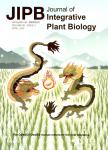Characterization of the Hemolytic Properties of an Extract from Phaeocystis globosa Scherffel
Characterization of the Hemolytic Properties of an Extract from Phaeocystis globosa Scherffel作者机构:CollegeofFoodandBiologyEngineeringSouthChinaUniversityofTechnologyGuangzhou510640China DepartmentofBiotechnologyJinanUniversityGuangzhou510632China
出 版 物:《Journal of Integrative Plant Biology》 (植物学报(英文版))
年 卷 期:2005年第47卷第2期
页 面:165-171页
核心收录:
学科分类:0710[理学-生物学] 071001[理学-植物学] 07[理学] 0901[农学-作物学] 0703[理学-化学] 0902[农学-园艺学]
基 金:国家自然科学基金,国家重点基础研究发展计划(973计划),广东省自然科学基金,暨南大学校科研和教改项目
主 题:hemolytic liposaccharides Phaeocystis globosa Scherffel toxin
摘 要:Phaeocystis globosa Scherffel, an organism that causes harmful algal blooms, is a genus of the family Prymnesiophyta (or Haptophyta) with eurythermal and euryhaline characteristics. P. globosa has been confirmed to produce hemolytic substances, which are a mixture of liposaccharides. In the present study, the hemolytic properties of extract of P. globosa are analyzed further. The effects of temperature, pH, different divalent cations, and membrane lipids on extract-induced hemolysis are discussed, as is the possible hemolytic mechanism. The results of the present study showed that the hemolytic activity of the extract was approximately 127.1 hemolytic units (HU)/L. The hemolytic reaction became fastest and a 50% decrease in absorbance was induced at 30 min at 37 °C, and at pH 7.0; Hg2+ was the strongest inhibitor of the hemolysis compared with the other divalent cations and many membrane lipids, except for phosphatidic acid, inhibited the hemolytic activity to different degrees. These results suggest that the toxin may make pores in the surface of red blood cells and that Hg2+ either combines with the hemolysin or closes the pores, hence inhibiting its further hemolytic reaction. The toxin probably has no specific membrane receptor in the red blood cell membrane.



